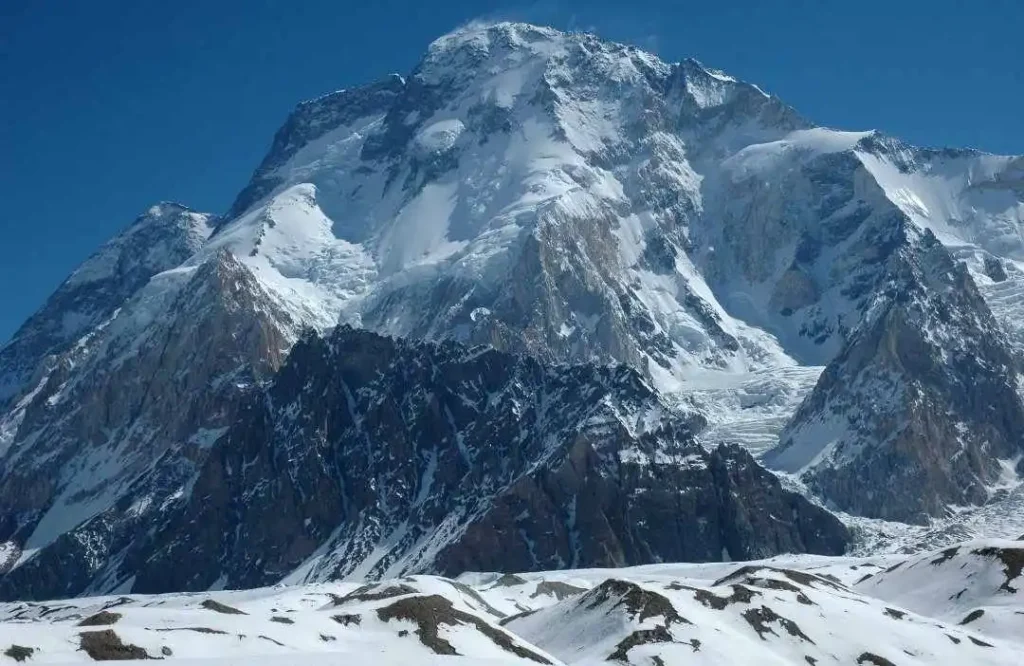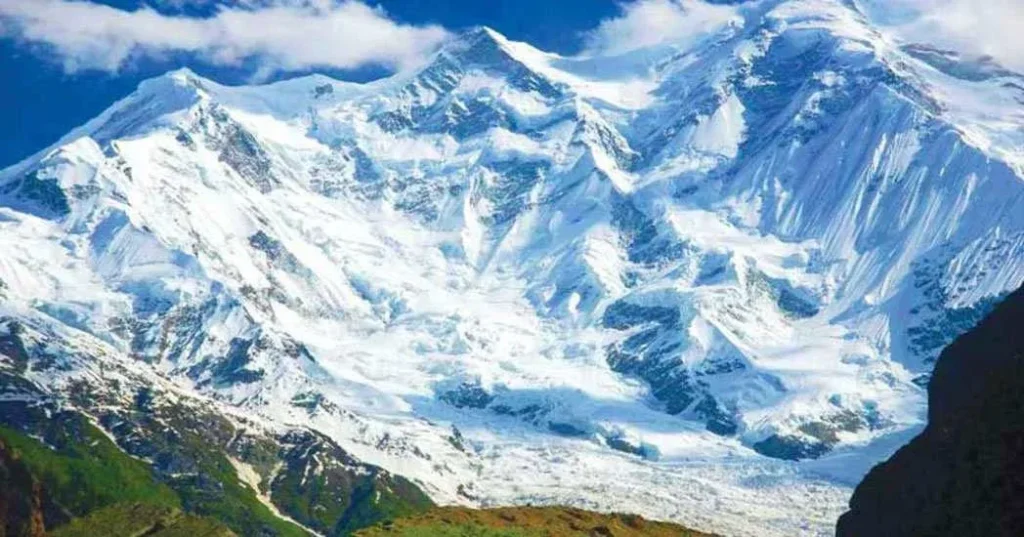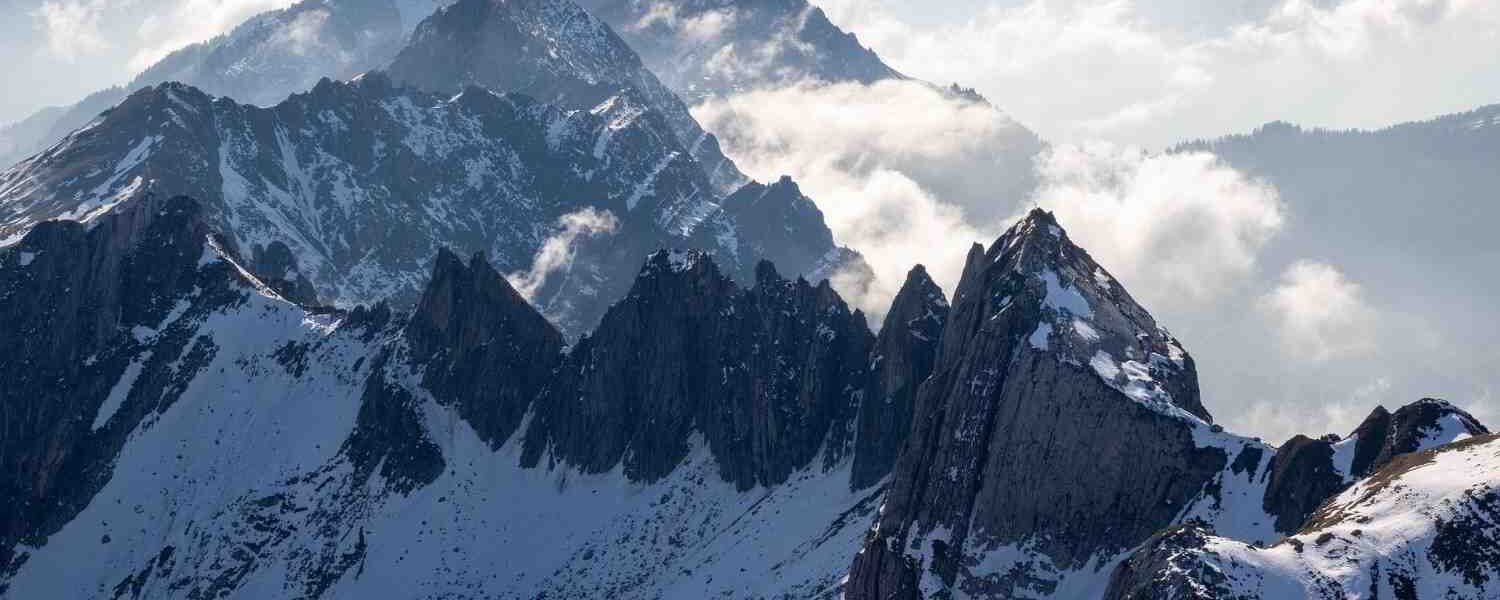Pakistan’s highest mountains in the northern region are iconic symbols of natural majesty and adaptability. Peaks like K2, the world’s alternate-loftiest mountain, and Nanga Parbat hold tales of frippery and discovery, attracting comers and trippers likewise with their stirring beauty and unmatched challenges.
Knowing which mountains are the highest and most dangerous in Pakistan is often challenging. Still, a beginner mountaineer can easily climb the higher peaks with proper guidance, equipment, and preparation.
This article will explore the top 15 tallest peaks in Pakistan and provide details of Pakistan’s famous mountain ranges. After reading this article, you can choose the best mountain in Pakistan that beginners and serious mountaineers can easily climb.
Top 10 Famous and Highest Mountains in Pakistan
K2 (Mount Godwin Austen)
Height: 8611m
K2, the world’s alternate-loftiest peak and Pakistan’s highest mountain, is at an altitude of 8,611 ( 28,251 bases). Due to its specialized challenges and rugged shells, it is notorious as the most challenging peak.
Due to its fatal and harsh climatic conditions, K2 is regarded as one of the most challenging mountains to climb in Pakistan. Covered with heavy snow and changing weather conditions, climbers need help reaching their peak. Many trekkers end their journey meeting with the K2 base camp, but some adventure seekers want to achieve a higher reputation and deadly success.

Roughly 300 rovers teach K2 climbing every time. The K2 Base Camp Trek demands proper medication for climbing, including regular exercise and adaptation, walking, and running to enhance cardiovascular endurance.
Nanga Parbat
Height: 8126m
Known as “The Killer Mountain,” Nanga Parbat is the second-highest peak in Pakistan, situated at an altitude of 8126m in the Gilgit Baltistan region of Pakistan.
Due to extreme and harsh difficulties and the mountain’s unpredictable climate, Nanga Parbat adds to the challenges, as the climber will be far enough from any resources needed for emergencies.
Nanga Parbat, being the Killer Mountain with an increasing fatality rate, has a sympathetic history as most of the climbers have faced death while climbing this mountain.
Gasherbrum I (Hidden Peak)
Height: 8080m
Gasherbrum, also called “The Hidden Mountain,” is located at an altitude of 8080m in the Karakoram Range of Pakistan. It is the 11th-highest mountain in the world.
Despite its smooth and flexible surfaces, climbers should gain expertise and perfect training before climbing this one of the highest mountains in Pakistan.
Gasherbrum I was first summited on July 5, 1958, by an American expedition led by Andrew Kauffman. The summit was reached via the southeast ridge, which remains one of the most commonly used routes to the top. The ascent of Gasherbrum I was a remarkable achievement in the history of mountaineering, as the mountain had previously been considered one of the highest peaks to climb in the Karakoram Range.
Broad Peak
Height: 8051m
Standing at an altitude of 8051m, Broad Peak is located in the Karakoram Range of Pakistan, also known as the 12th tallest peak encyclopedically. It’s 8 km from K2.
Broad Peak derives from its vast and extensive peak crests, divided into three dominant peaks: the prominent peak, the central peak( 8,016 measures), and the Rocky Summit( 8,028 measures). The massive crest is visible from long hauls down, presenting a striking image of power and scale.

An Austrian expedition led by Hermann Buhl, Fritz Wintersteller, Kurt Diemberger, and Marcus Schmuck was the first who successfully gained their destination and climbed the Broad Peak mountain. This outstanding achievement marked a landmark in Himalayan and Karakoram mountaineering. Mostly, seasoned and local mountaineers dare to climb this mountain.
Gaserbrum II, Pakistan:
Height: 8035m
At 8035m high, Gasherbrum is in the Karakoram Range of Gilgit Baltistan.
This mountain is also regarded as the 13th highest peak in the world. Though more technically challenging than some of the other 8,000-meter peaks, Gasherbrum II still poses a significant challenge due to its steep slopes, glaciated terrain, and harsh weather conditions.
Like other peaks, Gasherbrum 2 seems to be one of the most thrilling destinations to climb; however, due to its smooth and steady surfaces, the fatality rate at this mountain is very low, approximately 2%.
Distaghil Sir
Height: 7885m
Distaghil Sar, at an elevation of 7,885 meters (25,869 feet), is the seventh-highest peak in Pakistan and the 19th-highest globally. It is located in the Hispar Muztagh subrange of the Karakoram Range in the scenic region of Gilgit-Baltistan.
The mountain is flanked by large glaciers, including the Hispar Glacier to the south and the Shimshal Valley to the north. These glaciers offer stunning views and a challenging environment for climbers.
Structure: Distaghil Sar has three summits:
Main Summit: 7,885 meters
North Summit: 7,760 meters
West Summit: 7,488 meters
The first successful ascent was made via the West Ridge in 1960 by an Austrian expedition led by Wolfgang Stefan.
Batura I
Height: 7795m
Batura Sar, also known as Batura I, is one of the highest mountains in Pakistan, standing at an elevation of 7,795 meters (25,574 feet). It is part of the Batura Muztagh Range, a subrange of the Karakoram Mountains, located in the Hunza Valley of Gilgit-Baltistan.
Despite its emotional height, the mountain sees smaller rovers than other highest peaks like K2 or Nanga Parbat, mainly due to its closeness and grueling routes. The first successful ascent of Batura Sar was achieved in 1976 by an Austrian passage led by Hubert Bleicher. They climbed via the West Ridge.
Rakaposhi
Height: 7788m
Standing at an altitude of 7788m, Rakaposhi offers a mesmerizing view of Hunza’s beauty and terrain. Enjoy the shifting cautions of this beautiful geography, filled with lush green fields, Pakistan’s high mountain ranges, and emotional courses.
The Rakaposhi Base Camp trek starts from Minapin village, and after 2 to 3 days of trekking, you will reach Rakaposhi Base Camp. There are various cafes and restaurants where you can rest by traveling through a large area. Rakaposhi is the most famous and tallest mountain in Hunza Valley and an excellent photography point. If you want a camping adventure at Rakaposhi, Hapakun is the best trekking campsite.

Saltoro Kangri
Height: 7742m
Saltoro Kangri, standing at an elevation of 7,742 measures( 25,400 bases), is one of the tallest peaks in Pakistan. It’s part of the Saltoro Range, a subrange of the Karakoram Mountains, and is located near the Siachen Glacier in Gilgit-Baltistan. The mountain is positioned on the disputed border between Pakistan and India, adding geopolitical significance to its natural elevation.
Tirich Mir
Height: 7708m
Located at a high altitude of 7708 meters, Tirich Mir is Pakistan’s dominant and highest peak. It is well known for its unparalleled and extravagant beauty. Passing through picturesque views of different valleys, this journey blends extraordinary adventure and cultural and historical significance. Due to the fertility and population of Tirich Mir Valley, many travelers visit this place every year to make their minds fresh and healthy.
Chogolisa
Height: 7668m
Chogolisa, with an elevation of 7,668 meters (25,157 feet), is one of the prominent peaks in the Karakoram Range of Gilgit-Baltistan, Pakistan. Often referred to as the “Bride Peak” due to its elegant and dome-shaped summit, Chogolisa is a remarkable feature of Pakistan’s stunning mountainous landscape.
Haramosh
Height: 7409m
The Haramosh is one of the highest mountains of the Karakoram Range in Gilgit-Baltistan, Pakistan.
Haramosh Peak, standing at 7,409 measures, offers stirring views, dramatic geographies, and a sense of adventure that attracts seasoned pedestrians. The journey generally starts from the graphic villa of Sassi, leading through lush denes, rugged terrain, and high-altitude passes, with the Haramosh La Pass( 4,800 measures) being a significant highlight.
Baintha Brakk, Pakistan
Height: 7285m
Standing at an altitude of 7285m, Baintha Brakk is located in Pakistan’s highest mountain Range, also known as The Ogre.
Due to its steep and narrow vertical rock walls, Baintha Brakk has a high fertility rate of 20%. Although most mountaineers have attempted to climb it, it has rarely been climbed.
A Greman Team, led by Reinhard Carl, was the first to attempt this mountain successfully. Baintha Brakk requires more than physical skills; a climber must understand whole mountaineering strategies to overcome all the challenges during the journey. Mostly, seasoned and local mountaineers dare to climb this challenging mountain range in Pakistan.
Sikaram
Height: 4755m
Sikaram Mountain, standing at an elevation of 4,755 meters (15,528 feet), is the highest peak of the Spin Ghar Range (also called the Safed Koh Range). It is located on the border between Pakistan and Afghanistan, with its Pakistani side in the Kurram District of Khyber Pakhtunkhwa.
This peak is a testament to Pakistan’s mountainous geographies’ natural and artistic diversity. While it may not boast the extreme elevations of the Karakoram or Himalayan ranges, its beauty, ecological value, and strategic significance make it a notable point of the region.
Laila Peak
Height: 6096m
Laila Peak is one of the highest mountains in Pakistan. It’s positioned in the Shimshal Valley of Gilgit-Baltistan and has 6,096 measures( 20,030 bases). Laila Peak is notorious for its beauty, delicate shape, and dramatic, aggregate-like peak, making it a famous mountain range in Pakistan among rovers and perambulators seeking an aesthetic and gruelling ascent.
The standard route to the summit of Laila Peak is via its northeast face, which combines steep rock climbing and snow/ice climbing. The final push to the summit is particularly challenging due to the terrain and the high altitude. The best time to climb Laila Peak is during the summer months (June to August) when the weather is more favourable and the snow conditions are suitable.
Pakistan’s highest mountains are beyond just peaks; they are ensigns of natural wonder, adventure, and the insuperable spirit of exploration. After reading this article, you will be able to get enough knowledge about the highest mountains in Pakistan. The readers will explore the climbers’ difficulties and challenges while climbing these highest mountain ranges. Climbing Pakistan’s most challenging mountain is not only about a test of physical abilities, but it also needs some technical and mental abilities. High altitude problems, rugged terrains, and narrow peaks are significant problems that mountaineers face. From the potent K2 to the serene beauty of the Karakoram and Himalayan ranges, these topographies offer an unrivalled experience for rovers, climbers, and nature suckers.
FAQs
What is the best time to visit the highest mountains in Pakistan?
The best time to visit the highest mountains in Pakistan is typical during the summer, from June to September, when the weather is relatively more stable and trekking and climbing conditions are safer.
What other activities can visitors do in Pakistan’s mountain regions?
Visitors can engage in activities like trekking, camping, mountaineering, cultural tours, and exploring scenic valleys such as Hunza, Skardu, and Gilgit.
How many of the world’s 14 highest peaks are in Pakistan?
Pakistan is home to 5 of the 14 highest peaks in the world, including K2, Nanga Parbat, and others in the Karakoram and Himalayas ranges.
Is it safe to climb the highest mountains in Pakistan?
Climbing these mountains is challenging and risky due to harsh weather conditions, technical difficulty, and high altitudes. It requires proper preparation, experience, and a professional guide.


